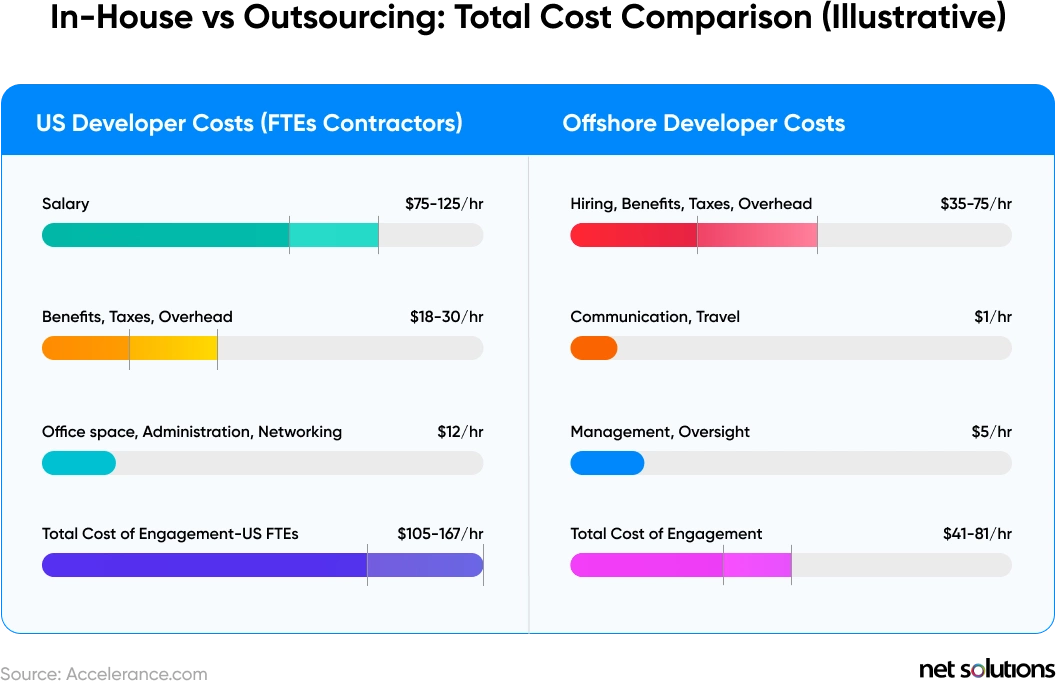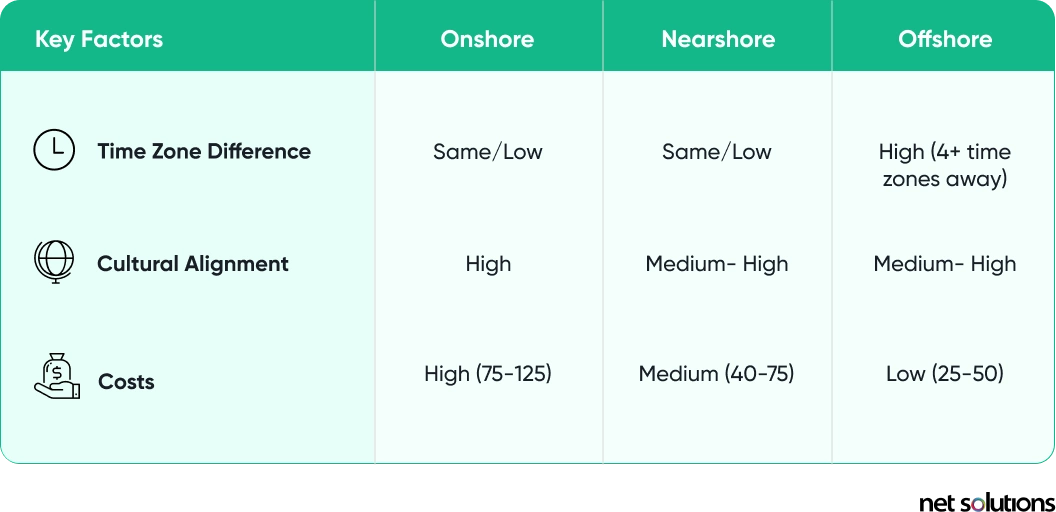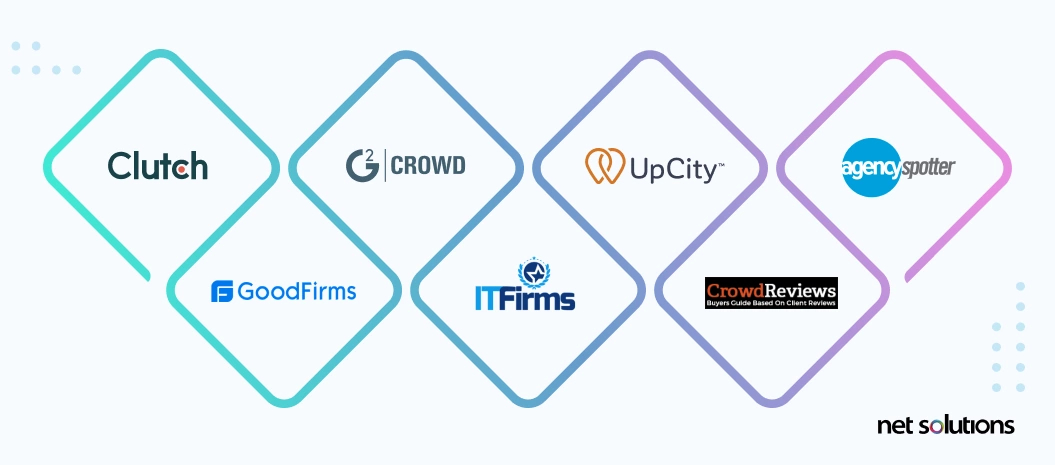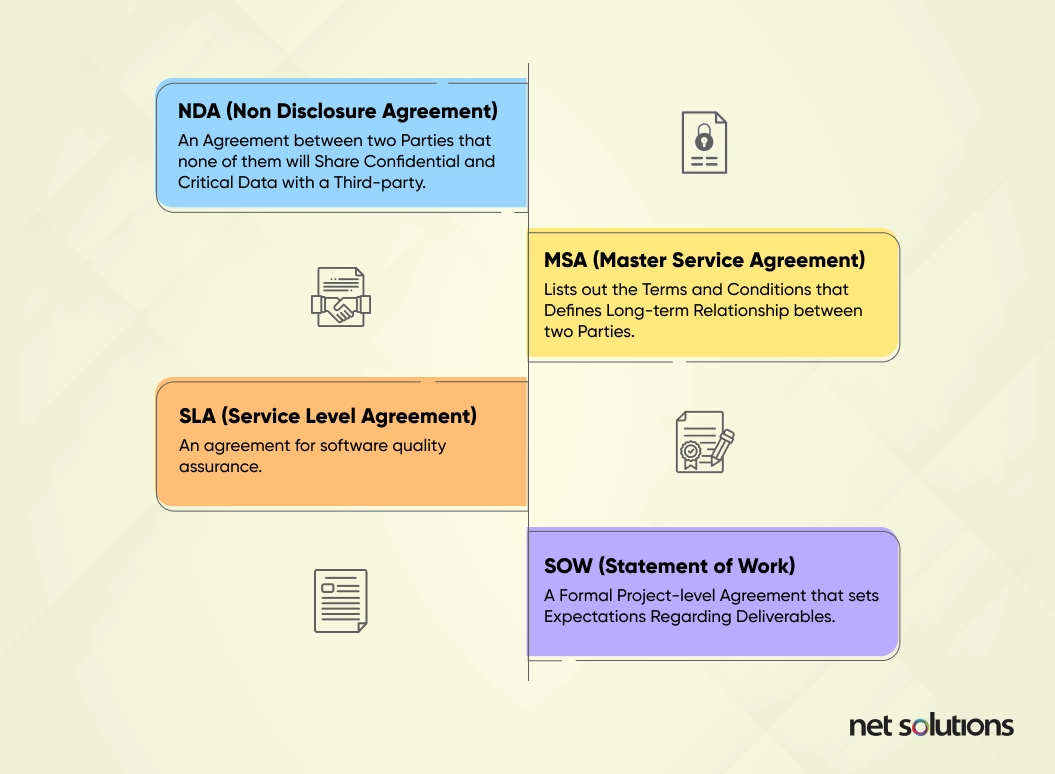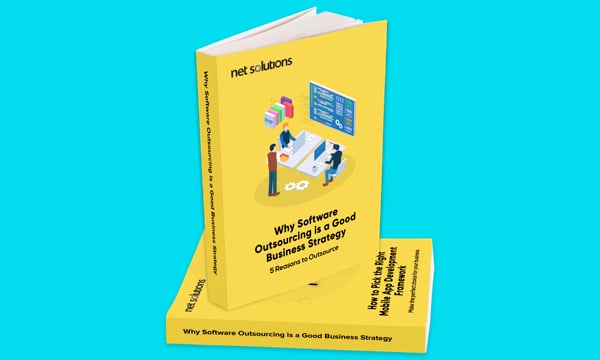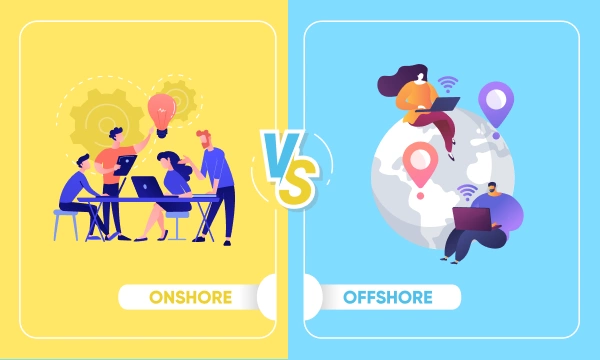According to a report from Accelerance, companies are expected to spend USD 133.3 billion collectively on outsourced development by 2025, and many of them will consider that money well spent. Some, however, will regret the decision.
The cold, hard truth about outsourcing software development is that some projects won’t succeed. The root cause of these failures can be a weak outsourcing process, choosing the wrong outsourcing partner, or failing to communicate requirements.
Let’s take a real-life example of a software outsourcing catastrophe. Cambridge University NHS Foundation Trust outsourced the development of an online patient record system. After the first launch, the software’s performance dropped by 20%. The error-prone system gave inaccurate information, risking patient privacy and data security. The IT project cost Cambridge University GBP 200 million (equivalent to around USD 300 million), leading to several funding-related investigations.

We respect your privacy. Your information is safe.
The first step to avoiding outsourcing issues is to plan everything in detail and take a systematic approach to finding the right software development partner. This guide will outline how to successfully outsource software development projects and maximize your odds of success.
Outsourced Product Development vs. an In-house Team
Outsourced product development and an in-house team have advantages and disadvantages. An in-house team can offer the benefits of direct communication with your teams, greater control, and lesser risk of intellectual property loss. However, you could end up with a more expensive process if you hire specialized developers. Hiring and training in-house teams could also take time, delaying the product launch. In-house teams reduce flexibility since you can’t scale your teams up or down as needed.
How does outsourced product development help?
The best way to decide whether to outsource product development or build an in-house team is to consider your specific needs and requirements. Outsourcing may be the best option if you are on a tight budget and need to get your product to market quickly. It can help you save time to focus on other aspects of your business. It gives you access to experienced developers with expertise in specific areas, such as mobile development or cloud computing.
Remember, software development outsourcing can pose communication challenges with different time zones, and you may have less control over the development process as you rely on the outsourcing company to deliver the product on time and to your specifications. At times, there could be a risk that your intellectual property could be lost or stolen when you outsource.
On a larger perspective, outsourced product development can offer the following benefits:
- Cost savings: Outsourcing can help you save money on labor costs, as you will not have to pay the salaries and benefits of in-house developers.
- Access to specialized skills: Outsourcing can give you access to specialized skills and expertise you may need to gain in-house. This can be especially helpful when developing a complex or cutting-edge product.
- Faster time to market: Outsourcing can help you get your product to market faster, as you will not have to wait to hire and train in-house developers.
- Flexibility: Outsourcing can give you more flexibility, as you can scale your team up or down as needed. This can be helpful if you are experiencing rapid growth or need to increase your capacity temporarily. It reduces your risk by working with a reputable company with a proven track record.
10-Step Process for Successfully Outsourcing Software Development Projects
The following process will improve your odds of success in software development outsourcing —whether you hire developers close to home or on the opposite side of the globe.
1. Develop clarity around what you’re building
It’s imperative to have clarity around what you’re trying to build. Once you’re clear about what you want, you’ll have an easier time communicating requirements to your development partners.
At a very high level, ask yourself:
- Is the concept tried and tested or brand new?
- Does the idea have a Proof-of-Concept (PoC)? Do you have technical validation for it?
- What technology will you base the software on?
- What problems will your software product solve for its intended audience?
A fundamental idea of what you want to build is essential before searching for an outsourcing partner.
2. Write a scope statement for your software project
Before choosing a software development outsourcing partner, you’ll want to dig deeper, fleshing out questions like objectives, deliverables, scope, content, and budgets. This will become the foundation for your project roadmap.
Here’s what a project scope template helps answer.
| Parameter: | What’s included? |
| a. Project Objectives | Define the high-level goals for your software project—who are you trying to serve, and what problem are you attempting to solve for them? Explain how the software project aligns with your business goals. Understand why you are developing software. For example, are you solving internal problems in your organization? Are you attempting to earn a profit? Are you modernizing legacy software? |
| b. Project Deliverables | What results are you expecting at the end of each sprint cycle (if you use an Agile approach)? Do you want to use it as an MVP (Minimum Viable Product) approach? Identify the results you expect to achieve at the end of the development process. |
| c. Identify What’s Out of Scope | What will your software project NOT cover? Defining the project scope will keep you from getting lost in the weeds and squandering your budget on features that won’t improve the project or move you toward your goals. |
| d. Define Project Constraints | When will you start working on the project? What is the estimated timeline for launching the MVP (if you’re using an MVP model)? What is the estimated timeline for launching a full-fledged software product? What are the key milestones for the project? What are the budget constraints? What are the regulatory constraints that the outsourced team must adhere to? |
| e. Hourly-Price Estimate | What are the estimated hours required to complete the project? What hourly rate can you afford to pay (identify a range)? |
| f. Approvals | Do all your stakeholders approve of the project scope? Include a complete list of all stakeholders, their designation, and approval status. |
3. Decision time: To outsource or not to outsource
It is time to decide between in-house development and outsourcing. Making an informed decision will require you to weigh several factors. While price isn’t the only factor to consider, competitive pricing is one significant benefit to outsourcing your software development offshore—especially if you find a competent team that understands your vision.
4. Decide between onshore, offshore, and nearshore outsourcing
When choosing an outsourcing partner, each potential vendor’s location is a significant factor that can affect not only price but also communication, efficiency, and the overall quality of the end product. To review and weigh options, companies that do software development outsourcing have identified three categories based on company location: onshore, offshore, and nearshore outsourcing.
- Onshore Outsourcing (i.e., onshoring): Choosing an outsourcing partner based in your country.
- Offshore Outsourcing (i.e., offshoring): Choosing an outsourcing partner based in a distant country.
- Nearshore Outsourcing (i.e., nearsourcing/nearshoring): Choosing an outsourcing partner based in a nearby country.
Here are some of the pros and cons of each model. Remember that many factors about nearshoring and offshoring can vary significantly from one company to the next, which we explain in more detail below.
Why do cultural alignment, english communication, and expertise vary?
Simply put, it’s a big, wide world out there. Certain countries, like India, have a massive English-speaking population, and many Indian professionals have attained exceptional fluency. Many also have an in-depth understanding of cultural differences and know how to solve communication gaps.
How can you determine if a potential outsourcing company has the communication skills, cultural alignment, and technical know-how to deliver a high-quality product? It’s simple. Look at their track record.
Have they worked with a range of companies, including international brands? Do they have case studies featuring client testimonials that support their claims of superior service? Any outsourcing partner (whether onshore, offshore, or nearshore) should be able to demonstrate a history of achievement. Otherwise, you’re risking a great deal by working with them.
5. Choose an outsourcing model
Relationship-based outsourcing comes in three forms: staff augmentation, managed teams, and project-based outsourcing. Choose the best model to fit your requirements, budget, and long-term plans.
a. Staff augmentation:
This model involves outsourcing staff from an outside organization temporarily, usually to complete a project. This is mainly done to bridge the talent gap at your organization. The outsourced staff works under your direction and helps your team cross the finish line.
We wrote another blog post where you can learn more about staff augmentation and the benefits it provides.
b. Managed or virtual teams:
The managed teams model is a hybrid between staff augmentation (see above) and the Project-based model, which we’ll discuss below. With managed teams, you hire an entire team of experts, including Business Analysts, Designers, QA Engineers, front-end and back-end developers, and more, to handle some or all of your project.
This team will often work in tandem with your in-house team and will often answer to your in-house Project Manager. Unlike the Staff Augmentation model, this model typically does not involve the day-to-day management of individual employees on your part.
c. Project-based model:
This outsourcing model turns team management over to your outsourcing partner’s Project Manager, who will work with you to create timelines and communicate your needs to their colleagues.
Project-based outsourcing doesn’t mean giving up complete control. You will still be involved in key decisions, including feature development and prioritization. It means you won’t have to worry about managing the outsourced team. It’s the most hands-off option available.
6. Shortlisting companies
You can narrow your search once you know what country you will outsource software development to.
Vetting software development agencies start with an in-depth internet search. The following tools will help you do just that.
a. Software development review websites
Websites such as Clutch, GoodFirms, G2 Crowd, Agency Spotter, and Crowd Reviews provide a curated list of companies for software development. You can search for the best software development agencies and filter them based on location, reviews, hourly rate, talent pool, and more.
b. Consult industry colleagues, clients, and friends
Talk to your friends and colleagues in your industry who have outsourced software projects. Their experience can help you shortlist a few agencies with experience in your sector. If they know what you do and have a proven track record, your odds of success will greatly increase.
c. Freelancing portals
Looking for software developers in freelancing portals is also a good idea. Some popular freelancing portals include Toptal, Upwork, Fiverr, Freelancer.com, and People Per Hour.
Some require you to list your project’s requirements and budget; others have you reach out to specific providers with your requests. You can often search through profiles and apply filters based on location, budgetary requirements, and other factors.
7. Evaluate providers
Once you’ve shortlisted your providers to a select few, it’s time to interview them and evaluate each one on a deeper level. Here are a few things to consider.
a. Company size
How big is the development firm? Do they have enough developers to deliver what you need?
b. Business longevity
How long have they been in business? We recommend a business that has been around for at least five years because you don’t want them to fold in the middle of your project.
c. Experience with the technology
Does the company have experience with the technology your software product will employ?
d. Software development process maturity
Does the agency have in-depth knowledge of the Software Development Life Cycle (SDLC) process?
e. Software development methodology
What software development methodologies are they prepared to use based on your requirements? Are they open to using Agile, Waterfall, or other methods based on your current processes (if you already have an internal team) or your preferences?
f. DevOps maturity
Does the company have experience executing Continuous Integration/Continuous Delivery (CI/CD) pipelines? Have they completed projects using the DevOps model in the past?
g. English proficiency
What is the company’s collective level of English proficiency? This is more important than you might imagine because software development requires nuanced discussions about the process, planning, design, usability, and more.
h. Time-zone flexibility
Will a company on the other side of the world match your work hours if you need them to? Sometimes, you may want something else (for example, we worked with one company that had us perform QA testing while their in-house developers slept). That said, if your outsourcing partner is willing to adapt to your work hours, should you require it, that’s a huge plus and speaks to their dedication.
i. Industry/Vertical experience
Has the company developed software for an industry similar to yours?
j. Pricing structure
Does the pricing structure match your requirements? Is the cost structuring transparent with no hidden charges involved?
k. Work portfolio
Who has the agency worked for in the past? Have they worked for recognizable brands?
l. Compliance certifications
Does the software outsourcing company comply with PCI-DSS, GDPR, or HIPAA compliance requirements?
m. GitHub contributions
Are there any Github contributions for your shortlist of potential partners?
n. Business continuity plan
Does the company follow a business continuity plan for emergencies? Is it safe to do business with them?
8. Request a free consultation
You can contact their sales team once you have shortlisted 4-5 software development agencies. Talk to their experts, request free consultations, ask for their work portfolio and case studies, and discuss their software development process, methodologies, programming language preferences, technology implementation, etc.
These conversations ideally involve discussions around:
- Software requirements
- MVP development criteria
- Collaboration term: short-term or long-form?
- Cost and development-time estimates
- Development roadmap
9. Draft and sign the paperwork
Once you have chosen a software development outsourcing partner that matches your requirements, the next step in the process is to draft agreements, such as:
- Non-Disclosure Agreement (NDA)
- Master Services Agreement (MSA)
- Services Level Agreement (SLA)
- Statement of Work (SOW)
Here’s what each of them comprises:
a. NDA
An NDA is an agreement between two parties that acts as a promise that none of the parties will share confidential and critical data or information with a third party.
The primary components of an NDA document identify:
- Critical and confidential information in the document
- Information that is not confidential and can be shared
- Software project’s Intellectual Property (IP) rights
- Duration for which the NDA is valid
- The consequences of breaking the NDA
b. MSA
An MSA lists the basic terms and conditions defining the long-term relationship between the two parties. If the MSA is in place, the two parties won’t have to renegotiate the terms in the future and can quickly move on with the development.
The primary elements of an MSA include:
- Project audit process
- Payment terms
- Dispute resolution process
- Support term: product lifecycle vs. project lifecycle
- The general confidentiality terms
c. SLA
An SLA is an agreement for software quality assurance. It measures the overall software performance based on industry-specific metrics.
The primary elements of an SLA spell out:
- Key Performance Indicators (KPIs) for measuring software quality and performance
- Communication, reporting, and process monitoring
- Support, maintenance, hosting, infrastructure, and development terms
- Information about backups and recovery protocols
d. SOW
The SOW acts as a formal project-level agreement that sets expectations regarding deliverables.
The primary elements of an SOW include:
- Project overview, along with a mention of its Unique Selling Points (USPs)
- Overview of the software development stages and what each will include
- Key performance indicators that help measure the success of the software project
- Deliverables (e.g., MVPs, full-fledged products)
- Development and deployment timelines
10. Choose a communication tech stack
With everything finalized, the last step in the software development process is choosing communication channels to track the development progress.
Some of the most trusted communication channels include:
- Basecamp, ClickUp, and Trello for project management
- Zoom, Google Meet, Microsoft Teams, and Webex for live meetings
- Slack, Rocket, and Chanty for chat-based communication tools
- Emails for managing formal communications
Things to Consider When Outsourcing Software Development
1. Analyze your problems and requirements.
What are you trying to achieve with the software? What are your specific needs and requirements? The more you can define your requirements, the easier it will be to find a suitable outsourcing partner.
2. Select the suitable model.
There are different ways to outsource software development, such as:
- Staff augmentation: This is where you hire a team of developers to work on your project alongside your in-house team.
- Project outsourcing: This is where you hire a company to develop your software from start to finish.
- White label development: This is where you hire a company to develop your software, but you rebrand it as your own.
3. Select an agency or freelancer.
Many agencies and freelancers offer software development services. When selecting a partner, it is essential to consider their experience, skills, and portfolio. You should also get references from previous clients.
4. Create a design and software specification document.
This document should clearly define your requirements for the software. It should include the user stories, wireframes, and technical specifications. This will help ensure the outsourcing partner understands your needs and can deliver your desired software.
5. Manage the project effectively.
Once you have selected an outsourcing partner, it is essential to manage the project effectively. This includes setting clear expectations, providing regular feedback, and resolving issues.
Mistakes to Avoid When Outsourcing Development
1. Selecting a misfit company:
Researching and selecting a company that fits your needs is essential. This means considering the company’s experience, skills, and portfolio. You should also get references from previous clients.
2. Not familiar with the cost of your product development:
It is important to understand the costs involved in your product development. This includes the cost of development, testing, and deployment. You should also factor in the cost of communication and coordination between you and the outsourcing company.
3. Lack of a strategic action plan:
It is essential to have a clear plan for your product development. This plan should include the project’s goals, the timeline, and the budget. You should also have a contingency plan in case of any unexpected delays or challenges.
4 Tips for Not Getting Scammed When Outsourcing Software Development
1. Know your goals:
Before looking for an outsourcing partner, you must clearly understand your goals. What do you want the software to do? What are your specific requirements? The more you can define your goals, the easier it will be to find a partner to meet your needs.
2. Thoroughly vet a contractor’s background:
Once you have a list of potential partners, it is essential to vet their backgrounds thoroughly. This includes checking their references, reviewing their portfolios, and verifying their credentials. You should also be wary of any partners who are unwilling to provide you with this information.
3. Be thorough in communication:
Communication is key to a successful outsourcing relationship. Be sure to communicate regularly with your partner, especially during the early stages of the project. This will help to ensure that everyone is on the same page and that there are no surprises down the road.
4. Ensure that data security is a top priority:
When outsourcing software development, ensuring your data is secure is important. This means working with a partner with a strong data security track record and who uses industry-standard security measures.
The Value of Software Development Outsourcing
Whether you are planning to start a SaaS business or create internal software, outsourcing software development to the right partner is cost-effective and can produce exceptional products.
According to a Deloitte report, cost reduction is the number one objective for outsourcing companies. Still, others include flexibility, speed to market, agility, and technical expertise surrounding the tools and languages used to create some of the most successful products today.
Are you thinking about software development outsourcing? Net Solutions has designed and developed thousands of exceptional software products over the past two decades. Contact us to learn more!
Frequently Asked Questions
1. How do I choose the right outsourcing partner?
Here are some factors to consider when choosing an outsourcing partner:
- Experience
- Skills
- Portfolio
- References
- Communication
- Price
- Security
2. What are the advantages and disadvantages of outsourcing software development?
Advantages:
- Cost savings
- Access to specialized skills
- Faster time to market
- Flexibility
- Reduced risk
Disadvantages:
- Communication challenges
- Loss of control
- Intellectual property risks
- Cultural differences
3. What are the future trends in outsourcing software development?
The future trends in outsourcing software development are likely to include:
- Increased use of artificial intelligence (AI) and machine learning (ML)
- Increased focus on security
- Increased demand for agile development
- Increased use of cloud computing
4. What are the challenges of outsourcing software development?
The challenges of outsourcing software development include:
- Communication
- Quality control
- Security
- Compliance
- Managing the relationship


